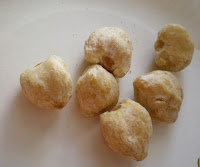
Kecap manis (sweet soy sauce) - You can find this at most Asian grocery stores, especially those that sell Filipino food, and is an essential part of almost all stir-fries, sauces, and also as a general condiment.

Palm sugar - You can find this at any Hispanic grocery store. It is red and comes sold in blocks that you can shave with a knife. It's really sweet. A good substitute would be dark brown sugar, but it's so cheap that you should really try to find it. On a side note, palm sugar is a fantastic topping for oatmeal, which we have been eating for breakfast here.

Kaffir lime leaves - These can be hard to find in the States. They freeze very well, though, so if you find them, buy a ton of them and save them. Sometimes you find them dried. These are used to flavor stews.

Daun salam (Salam leaves) - These are the Indonesian equivalent of bay leaves, used to flavor soups and curries. We suspect that you cannot find these outside of SE Asia though, and there really is no substitute.

Galangal - This is like ginger, but different. It looks like ginger and has a similar taste, but its consistency is a little more woody. You should be able to find it in South Asian grocery stores, but often only in powdered form. If you can't find it, just use more ginger.

Fresh turmeric - This is nothing like the neutral yellow powder you find in the West. It's a root and it looks like ginger or galangal, but once you peel it it's bright orange inside with a distinct, subtle flavor. Beware, though, it will dye your cutting board, fingers, and clothes a bright yellow. If you can't find this, just use the powdered stuff.

Candlenuts - These are like macadamia nuts, and they can be used interchangeably. Apparently, raw candlenuts, which they sell in the stores here, are poisonous, so don't forget to toast them.

Tamarind - This is a sour fruit, usually sold in a pulp form with a distinctly sour flavor. To make tamarind water, take 1 part tamarind paste and 2 parts water, mix together and let stand for 15 minutes. This is usually available in Hispanic or South Asian grocery stores.

Tauco - This is a fermented salted soybean paste which has a very pungent smell. It's good once fried, though, and flavors many dishes influenced by Straits Chinese cooking. Maybe one of our friends who is familiar with some Chinese dialect can tell us if this is present in some regional Chinese cuisine (it's pronounced TOW CHO). You can find this at East Asian grocery stores.

Krupuk - We have eaten these almost every day since we've been here, but still have no idea what they actually are. They are basically chips made up of some sort of puffed grain that you deep fry until they're crispy. They come in several flavors, including garlic, tempe, and shrimp. We think that you might find them at a store that sells Filipino foods.

Glutinous rice flour and tapioca flour - These are used to make a number of Indonesian snacks. They are available at any Asian grocery store, and possibly at health food or vegetarian stores.

Lumpia skins - These are the Indonesian versions of eggroll wrappers. They are the same as Filipino eggroll wrappers too, and might be the same as the Chinese kind as well, but we don't really know. If you can't find the special Filipino kind, you can substitute with the Chinese kind available at any Asian grocery store.

Banana leaves - We don't know where you can find these, seeing as we haven't been able to find them here. We think that they are available fairly easily in the US though, probably at Hispanic markets. In Indonesian cooking, banana leaves are used to wrap things for steaming, in particular fish, rice, and sweets.

Cellophane Noodles - In Indonesian, Malaysian, and Straits Chinese cooking, these are known as bihun (spelled bee hoon in Singapore and Malaysia). They may or may not be the same thing as rice vermicelli. They are often served stirfried or in soups, but you can also deep fry them while still dry to make a crunchy garnish. You can find them at any Asian market.

Egg noodles - These are the other big kind of noodle served in Indonesian cooking. They are long, yellow, and sort of curly, and they are available either fresh or dried. Dry versions will definitely be available at any Asian market, but try to find the fresh ones if possible.







No comments:
Post a Comment